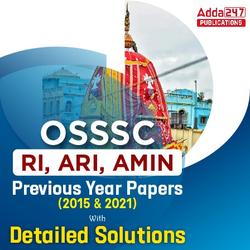Chemistry is an integral part of general science and plays a crucial role in various competitive exams like OSSSC LSI, Forester, and FG. To help you prepare effectively, here are the top 30 multiple-choice questions (MCQs) covering various concepts in chemistry.
Top 30 Chemistry (General Science) MCQs for OSSSC LSI, Forester, FG
These 30 multiple-choice questions cover a broad range of topics in chemistry, including elements, compounds, chemical reactions, and the properties of matter. Practicing these questions will help you solidify your understanding of chemistry concepts and prepare effectively for OSSSC LSI, Forester, and FG exams.
- In which form is the chemical compound RDX used?
A. As a composition
B. As a reactor
C. As an explosive
D. As a nuclear weapon
Ans: C - As a vegetable preservative, poly______ foam is used.
A. Uthane
B. Uriathenes
C. Urathanes
D. Urethanes
Ans: D - Chemistry is a branch of science which can be used for providing services to mankind. Comment on the statement.
A. True
B. False
C. Maybe
D. Strongly not
Ans: D - Biochemical compounds are used as….
A. Skin Treatments
B. Food preservatives
C. Cooking Oils
D. All of the above
Ans: D
| Set I | Set II |
|---|---|
| a. Fertilisers | 1. Constructive and destructive matter |
| b. Nuclear Bomb | 2. Cooking Gas |
| c. LPG | 3. Curse of chemical reactions |
| d. Carbon | 4. Advanced process |
- Match the following:
Code: a b c d
A. 3 4 2 1
B. 1 2 3 4
C. 4 1 2 3
D. 2 3 4 1
Ans: B - What is the composition of soap?
A. Sodium salt with fatty acids.
B. Potassium salt with fatty acids.
C. Both A and B.
D. Sodium and potassium salt mixed with chemicals.
Ans: C - How is detergent defined?
A. A liquid surfactant.
B. A liquid soluble.
C. A liquid solvent.
D. A liquid solution.
Ans: A - Which of the following compounds is not used as an alkali?
A. Sodium hydroxide.
B. Potassium hydroxide.
C. Carbon hydroxide.
D. Nitrogen hydroxide.
Ans: D - What is toxicity?
A. A chemical reaction.
B. A process used in the manufacturing of detergents.
C. A harmful effect of soaps and detergents required to measure the effectiveness.
D. A process used in the manufacturing of soaps.
Ans: C - Match the following:
Set I
a. A Fatty Acid
b. Potassium Hydroxide
c. Non-ionic Surfactants
d. Neutralization
Set II
Better Alkali
Process to make detergent
Process to make soap
Oil and fats
Code:
a b c d
A. 3 4 2 1
B. 1 2 3 4
C. 4 1 2 3
D. 2 3 4 1
Ans: C - Which of the following is not a form of Biocides?
A. Salt
B. Iodine
C. Sugar
D. Bleach
Ans: D - How do biocides primarily work?
A. Control the multiplication of insects
B. Kill the insects
C. Manage the original form of material
D. Control bacteria
Ans: D - What is a Rodenticide?
A. A medicine to kill worms
B. A medicine to kill animals
C. A lubricant
D. A pesticide
Ans: D - Most commonly used Rodenticides are _______ in nature.
A. Anti-pesticides
B. Anti-solvent
C. Anti-coagulant
D. Non-anti-coagulant
Ans: C - Which acid is present in lemon?
A. Marlic acid
B. Citric acid
C. Lactic acid
D. Tartaric acid
Ans: B - Natural rubber is a ________ which is having high elasticity.
A. Substance
B. Material
C. Elastomer
D. Chemical using carbon as the main compound
Ans: C - How would you define the process of Vulcanization?
A. Sample of butane mixed with sulfur and litharge
B. Sample of propane mixed with sulfur and litharge
C. Sample of plastic formed carbon mixed with sulfur and litharge
D. Sample of rubber mixed with sulfur and litharge
Ans: D - What is NBR?
A. Normal Acrylonitrile-butadiene rubber
B. Natural Acrylonitrile-butadiene rubber
C. N Acrylonitrile-butane rubber
D. Acrylonitrile-butadiene rubber
Ans: D - A synthetic rubber has ________ weight.
A. Higher resistance
B. Lower density
C. Higher molecular
D. Higher atomic
Ans: C - Which of the following is not a type of element?
A. Metals
B. Non-Metals
C. Metalloids
D. Gases
Ans: D - In which form is natural petroleum found?
A. Gaslette
B. Kerosene
C. Crude Oil
D. Tar
Ans: C - Which country consumes the maximum petroleum?
A. Saudi Arabia
B. India
C. UK
D. US
Ans: D - In which field is petroleum not used?
A. Automobile
B. Petrochemical
C. Medical
D. Marketing
Ans: D - Petroleum is a combination of chains of hydrogen and ________ present in the earth’s crust.
A. Butana
B. Hydrocarbon
C. Carbon
D. Proplene
Ans: C - Which of the following statements is incorrect?
A. Atomic radius of the elements increases as one moves down the first group of the periodic table
B. Atomic radius of the elements decreases as one moves across from left to right in the 2nd period
C. Amongst isoelectronic species, smaller the positive charge on the cation, smaller is the ionic radius
D. Amongst isoelectronic species, greater the negative charge on the anion, larger is the ionic radius
Ans: C - Green solvents are derived from ________.
A. Renewable resources
B. Carbon resources
C. Non-renewable resources
D. All of these
Ans: A - Eating tobacco and throwing it on the road can produce ________ pollutant.
A. Air
B. Soil
C. Noise
D. Water
Ans: B - Which of the following is not a greenhouse gas?
A. CO
B. O3
C. CH4
D. H2O Vapour
Ans: A - Which of the following is not a component of photochemical smog that occurs in warm, dry, and sunny climates?
A. NO2
B. O3
C. SO3
D. Unsaturated hydrocarbon
Ans: C - Which of the following treatments is used for the removal of biological impurities?
A. Sedimentation
B. Boiling
C. Sterilization
D. Distillation
Ans: C





